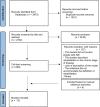Rehabilitation models that support transitions from hospital to home for people with acquired brain injury (ABI): a scoping review
- PMID: 37525270
- PMCID: PMC10388520
- DOI: 10.1186/s12913-023-09793-x
Rehabilitation models that support transitions from hospital to home for people with acquired brain injury (ABI): a scoping review
Abstract
Background: Research shows a lack of continuity in service provision during the transition from hospital to home for people with acquired brain injuries (ABI). There is a need to gather and synthesize knowledge about services that can support strategies for more standardized referral and services supporting this critical transition phase for patients with ABI. We aimed to identify how rehabilitation models that support the transition phase from hospital to home for these patients are described in the research literature and to discuss the content of these models.
Methods: We based our review on the "Arksey and O`Malley framework" for scoping reviews. The review considered all study designs, including qualitative and quantitative methodologies. We extracted data of service model descriptions and presented the results in a narrative summary.
Results: A total of 3975 studies were reviewed, and 73 were included. Five categories were identified: (1) multidisciplinary home-based teams, (2) key coordinators, (3) trained family caregivers or lay health workers, (4) predischarge planning, and (5) self-management programs. In general, the studies lack in-depth professional and contextual descriptions.
Conclusions: There is a wide variety of rehabilitation models that support the transition phase from hospital to home for people with ABI. The variety may indicate a lack of consensus of best practices. However, it may also reflect contextual adaptations. This study indicates that health care service research lacks robust and thorough descriptions of contextual features, which may limit the feasibility and transferability to diverse contexts.
Keywords: Acquired brain injury; Care trajectory; Early supported discharge; Health care services; Rehabilitation; Transitional care.
© 2023. The Author(s).
Conflict of interest statement
The authors declare no competing interests.
Figures
References
Publication types
MeSH terms
LinkOut - more resources
Full Text Sources


